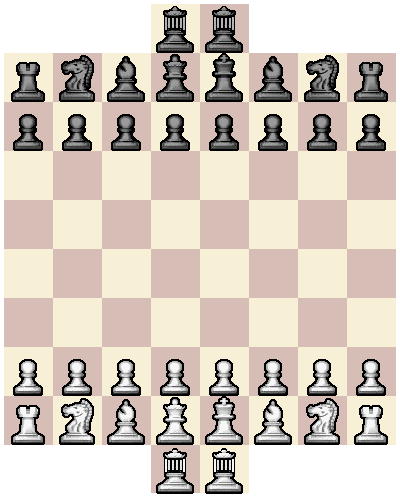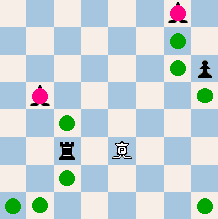

The Gladiatrix is a bifurcation piece. It moves by colliding, diagonally or orthogonally, against any piece, and then deviating to any of the two adjacent orthogonals or diagonals (in the prolonged movement direction). It captures on the second leg only. The Gladiatrix can also move by colliding against the margin, whereby only one movement direction is available after collision. Without screens to collide against the Gladiatrix cannot move. The Gladiatrix's value is 6, which corresponds to rook + pawn (preliminary estimate). Other rules are the same as in standard chess, except for the possible promotion to Gladiatrix.
The Gladiatrix is the most powerful of the bifurcation pieces. It is, arguably, the most agile among all known pieces. It has the capacity of zigzaging between the pieces and find its way in quite congested situations. As it moves by coordinating with other pieces, the Gladiatrix is a highly cooperative piece. The structure on the board decides its possibilities. Although screens for colliding become fewer, the Gladiatrix does not loose power in the endgame. But, unlike the rook, the Gladiatrix cannot, together with the king, give mate to the enemy king.
Gladiatrix Chess can also be played with Kwaggas instead of knights. Gladiatrix Chess, and the new Gladiatrix piece, were invented by undersigned, February 2007. The Kwagga was originally invented for my Bodyguard Chess. As proved by Troitsky, two knights can give mate on this type of board that has a two-square "dungeon". One must first force the king into the dungeon. As the knights cannot gain tempo, it might be necessary to triangulate with the king. See Troitsky's analysis here.
Gladiatrix (pl. Gladiatrices) : female gladiator in ancient Rome. Female gladiators were often from upper-class families, seeking thrill and attention. Gladiatrices were banned around AD 200 under the rule of Emperor Severus.
 The Gladiatrix moves in two legs, the first is a queen slide and the second is a collision-move. Both movement and capture occur on the second leg (red = capture).
The Gladiatrix moves in two legs, the first is a queen slide and the second is a collision-move. Both movement and capture occur on the second leg (red = capture).
 The Gladiatrix's movement principle. The screens, that are used for colliding, occur anywhere on the first leg.
The Gladiatrix's movement principle. The screens, that are used for colliding, occur anywhere on the first leg.
See also: Female gladiator (Wikipedia article)
• You can download my free Gladiatrix Chess program here (updated 2007-03-25), but you must own the software Zillions of Games to be able to run it (I recommend the download version).
• Don't miss my other chess variants.
© M. Winther (March 2007).